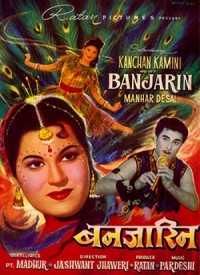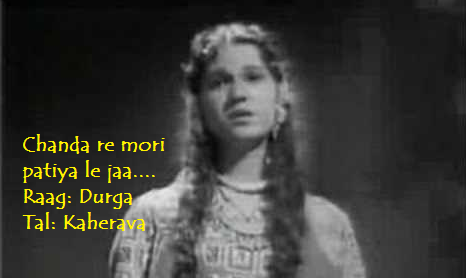Raaga Based Song of the Day: Chanda re mori patiya le jaa…
Raag Durga, Tal Kaherava
We have completed thirty-seven days of Raaga Based Songs of the Day. Our first post in the series was titled ‘Raaga Based Song Of The Day #1’ and the song was a Mohammad Rafi and Lata Mangeshkar song from the 1970 Shakti Samanta movie Pagla Kahin Ka: Tum mujhe youn bhula na paoge. It is in Raag Jhinjhoti, Tal Kaherava.
Our thirty-seventh post was titled ‘Raaga Based Song Of The Day #37’ and the song was a Lata Mangeshkar & Mohammad Rafi song from the 1963 V Shantaram movie Sehra: Tum toh pyaar ho sajna. It is in Raag Maru Bihag, Tal Kaherava.
This blog has a number of posts on Raaga based songs in Hindi movies titled similarly; for example: ‘The Best Raaga Based Songs in Hindi Movies – Raaga Yaman – Part III’.
In the last thirty-seven days of sharing Raaga based songs of the day, I have given you songs based on Raag Jhinjhoti, Gara, Bhimpalasi, Madhuvanti, Shivaranjani, Bihag, Pahadi, Sarang, Pilu, Bhairavi, Khammaj, Charukesi, Kalyan or Yaman, Desh, Malgunji, Kirwani, Kedar, Bageshri, Megh Malhar, Bhupali, Ahir Bhairav, Malkaush, Adana, Kafi, Rageshri, Jaunpuri, Tilang, Janasammohini, Chayanat, Shuddha Kalyan, Gaur Sarang, Jogiya, Asavari and Maru Bihag. The only raag that has been repeated so far is Pahadi, the raaga of my home place.
Today, I give you a song in Raag Durga, Tal Kaherava.
However, first, lets take up the value added learning of today. Today, we shall learn about Pakhawaj:
The pakhawaj (To be pronounced as पखावज) or mridang is an Indian barrel-shaped, two-headed drum, a variant and descendant of the older mridang. The larger bass skin of the drum is to the left of the player and the smaller treble skin to the right. I told you, a few days back, about Dhrupad. Pakhawaj is widely used as an accompaniment in Dhrupad and in other forms of music and dance. The pakhawaj has a low, mellow tone, very rich in harmonics.
The word Pakhawaj (Prakrit word) is derived from two words: the first is Paksha (a side), and Vaadya (a musical instrument). I told you that it is modern variation of Mridang. In the 14th century, Mridangists started experimenting with material used for its construction and replaced clay with wood. This gave birth to Pakhawaj.
Just like Tabla, Pakhawaj is used to produce rhythm (Tal) by a series of mnemonic syllables called bol. Naturally, the playing technique varies from that of tabla: in the bass face, the artist hits with his whole palm instead of the finger tip hitting which is done in tabla. In the treble face, the artist hits his whole palm with the fingers properly placed on the skin to produce different bols.
In Pakhawaj, a student learns various strokes to produce different bol. The very basic capacity is to play a theka in a particular tala or rhythmic cycle. I have already been giving you various theka that can be played.
Advanced students learn reelas that are virtuoso pakhawaj compositions.
As I mentioned, today’s song is composed in Raag Durga, Tal Kaherava.
Durga is another raaga that has been named after gods and goddesses. It belongs to the Bilawal Thaat. It is to be sung during the second prahar of the night: from 9 PM to midnight. Its Jati is Audhav-Audhav, that is, five notes each in Aaroha and Avroha. All notes or swar used are Shuddha (the raag is called Shuddha Saveri in the South). The two swar that are not used are: Gandhar and Nishad (Gaa and Ni). This Raag creates a very soothing atmosphere which is neither very deep nor very playful.
Some of the other songs composed in Raag Durga are:
| 1. 2. 3. 4. 5. |
Khet Ko Mooli Baag Door Desh Ka Geet Gaya Pattharon Ne Jaane Wale O Mere Sason Ke Taar Par |
Achuut Kanya Jawab Geet Gaya Pattharon Ne Geet Gaya Pattharon Ne Geet Gaya Pattharon Ne |
Ashok Kumar, Devika Rani Kanan Devi Kishori Amonkar Asha Bhosle Asha, Mahendra Kapoor |

I have taken today’s song from the 1960 movie Banjarin directed by Jaswant Jhaveri. The movie starred Manhar Desai, Kanchan Kamini and Dalpat. The song is a popular song even after 57 years of its original release.
Pt. Madhur penned the song and Pardesi composed it.
Please enjoy Lata Mangeshkar and Mukesh sing in Raag Durga, Tal Kaherava: Chanda re mori patiya le jaa….
la : nainaa to dukhan laage
chandaa re morii ( patiyaa.n le jaa ) -2 saajan ko pahu.Nchaa de re
vo likh sake javaab unhe.n tuu meraa pataa bataa de re
chandaa re
mu : chandaa re morii ( patiyaa le jaa ) -2 sajanii ko pahu.Nchaa de re
vo likh sake javaab …
la : palako.n kii hai kalam banaa_ii kaajal bah kar banii siyaahii
kaise likhuu.N kahaanii Gam kii tuu hii mujhe bataa de re
chandaa re …
mu : ham Kush hai.n Gam diyaa hai tuune ye ehasaan kiyaa hai tuune
jahaa.N raho Kush raho merii is du_aa kaa asar dikhaa de re
chandaa re …
do : o aakaash ke sundar darpaN tuu hii sajanii tuu hii saajan
bichha.De dilo.n ko phir se milaa de rotaa chaman ha.Nsaa de re
chandaa re …
We have intended to learn about Raaga based music whilst we entertain ourselves with Raaga based songs. So, lets, once again, take stock of our collective learning so far:
- On the first day we learnt about the Raaga system devised by Pandit Vishnu Narayan Bhatkhande, which is the prevalent system in Hindustani Classical Music and based on ten Thaats.
- On the second day we learnt about Tal or Taal.
- On the third day we learnt about characteristics of Raagas that included Swar, Jati, Thaat, Arohana and Avarohana, Vadi, Samvadi and Pakad.
- On the fourth day, we learnt about Sargam.
- On the fifth day, we learnt about notations used in Indian classical music or simply Swar Lipi.
- On the sixth day, we learnt about the Ras (sentiments) that Raagas evoke.
- On the seventh day, we learnt about various types of Swar: Shuddha, Achal, Vikrut, Komal and Teevra.
- On the eighth day, we learnt the parts of a composition in Indian Classical Music.
- On the ninth day, we learnt the names of some of the popular instruments used in Indian Classical Music.
- On the tenth day, we learnt about the sources of names of Raagas.
- On the eleventh day, we learnt about why Bhairavi is the first raag to be taught to beginners and also why it is the last in a performance.
- On the twelfth day, we learnt about Khammaj Thaat.
- On the thirteenth day, we learnt about Tal Punjabi Theka or Sitarkhani.
- On the fourteenth day, we learnt about Alap.
- On the fifteenth day, we learnt about List of Raagas (Raagmala) in my favourite book: Sri Guru Granth Sahib.
- On the sixteenth day, we learnt about tips for raaga identification.
- On the seventeenth day, we learnt the basics of Gharana system.
- On the eighteenth day, we learnt about Filmi Sangeet.
- On the nineteenth day, we learnt about the commonest Tal in Raagas: Tintal.
- On the twentieth day, we learnt about the Kafi Thaat.
- On the twenty-first day, we learnt a little more in detail about the classification of Raagas.
- On the twenty-second day, we learnt the essential differences between Bhairavi and Bhairav.
- On the twenty-third day, we learnt a little more in detail about the Jati or Jaati of a raaga.
- On the twenty-fourth day, we learnt details of Thaat Bilawal, the most basic thaat in the Bhatkhande’s system of raagas.
- On the twenty-fifth day, we learnt about Tintal.
- On the twenty-sixth day, we learnt in detail about the Raaga – Samay linkage.
- On the twenty-seventh day, we learnt about Lehar.
- On the twenty-eighth day, we learnt about the history of the Hindustani Music.
- On the twenty-ninth day, we learnt about Dhrupad.
- On the thirtieth day, we learnt about Rupaktal that I was introduced to, a few months back, by my friend Anand Desai.
- On the thirty-first day, we learnt about Khayal.
- On the thirty-second day, we learnt about Thumri.
- On the thirty-third day, we learnt about Tappa.
- On the thirty-fourth day, we learnt about Tarana.
- On the thirty-fifth day, we learnt about Tal Dipchandi (Moghali).
- On the thirty-sixth day, we learnt about Tabla.
- On the thirty-seventh day, we learnt about Kirtan.
- And today, on the thirty-eighth day, we learnt about Pakhawaj.
There is much more still to be learnt and enjoyed.
Please stay tuned!
